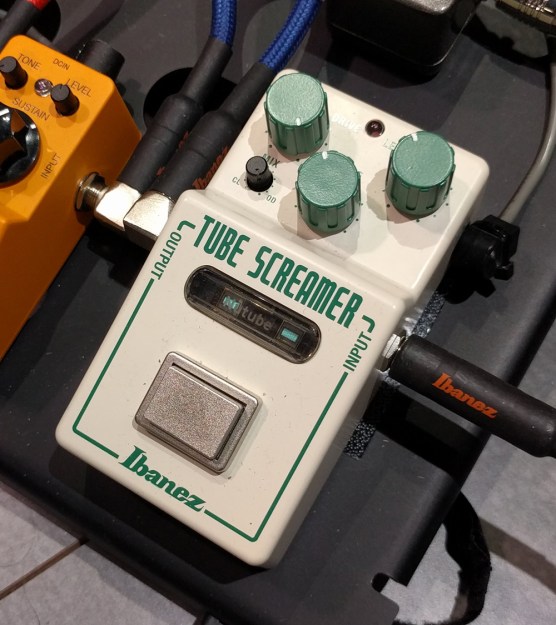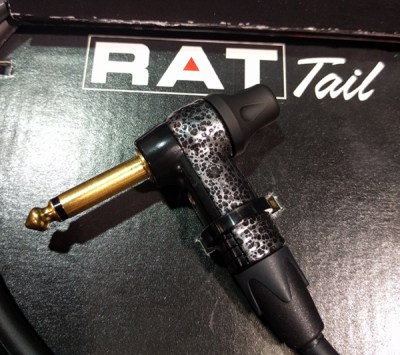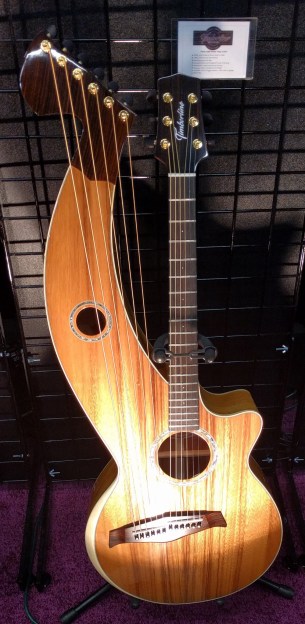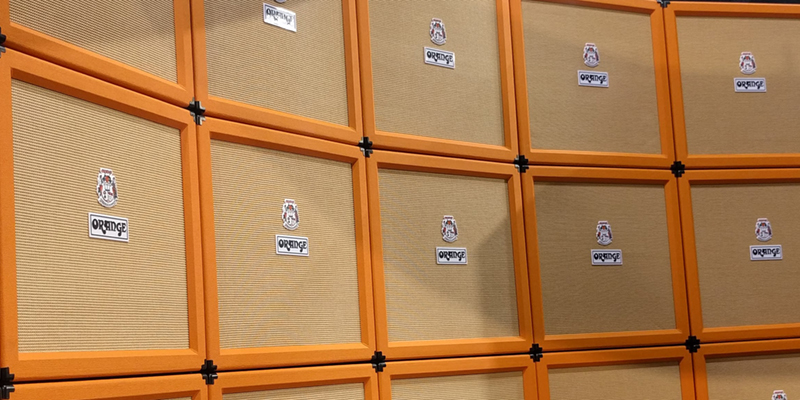Winter NAMM is the world’s largest trade show for musical instrument makers. It is a gear head’s paradise, filled to the brim with guitars, synths, amps, MIDI controllers, an impossibly loud section filled with drums, ukuleles, and all sorts of electronic noisemakers that generate bleeps and bloops. Think of it as CES, only with products people want to buy. We’re reporting no one has yet stuffed Alexa into a guitar pedal, by the way.
As with all trade shows, the newest gear is out, and it’s full of tech that will make your head spin. NAMM is the expression of an entire industry, and with that comes technical innovation. What was the coolest, newest stuff at NAMM? And what can hackers learn from big industry? There’s some cool stuff here, and a surprising amount we can use.
Low Power Tubes
A few years back, Korg announced the NuTube, most likely the first new design of a vacuum tube in several decades. The NuTube 6P1 is a dual triode meant for preamp applications and can be seen as a very, very low power 12AX7. The technology behind the NuTube is the same as vacuum fluorescent displays, and even though you can use VFDs as tube amplifiers, this is a purpose-built tube designed for modern, low-power applications.
 In the years since the NuTube has found its way into the new Vox Continental organ, but now we’re seeing novel applications of this fairly new, somewhat ancient technology. It’s in a guitar pedal. A Tube Screamer, specifically.
In the years since the NuTube has found its way into the new Vox Continental organ, but now we’re seeing novel applications of this fairly new, somewhat ancient technology. It’s in a guitar pedal. A Tube Screamer, specifically.
The Tube Screamer is a family of guitar pedals going back thirty years, and the circuit is fairly simple: take an op-amp, put some silicon clipping diodes in the feedback of the op-amp, and put it in a green box. The new tube-based Tube Screamer still uses an op-amp, but replaces the silicon clipping diodes with the NuTube. The dual triode NuTube is wired up with each half anti-parallel to ground in the feedback loop of the op-amp. The result? Well, given the demos released so far and what the people on the Internet say, this just sounds like a normal Tube Screamer. The blue lights in the NuTube do fade in and out depending on how hard you’re playing, so that’s cool, I guess.
Miniaturization in the guitar cable
 Concerning other technological advances peripherally related to guitar pedals, here’s another vintage distortion pedal made new once again.
Concerning other technological advances peripherally related to guitar pedals, here’s another vintage distortion pedal made new once again.
The ProCo RAT is an op-amp (an LM308 for the tone snobs) with some clipping diodes in the feedback loop. If you’re noticing a pattern here, you too can design guitar effects. The RAT sounds great, but there’s always room for improvement, right?
Introducing the RAT Tail. It’s a guitar cable with a little bit of microcircuitry built into one plug. Effectively, you’re looking at a right-angle 1/4″ jack with a three-position rotary switch on it. Position one is bypass, position two is the classic RAT sound with unity gain, and position three adds +3dB of boost. It’s powered by two coin cells, and I couldn’t manage to open up the display item for a look at the guts inside. Is the RAT Tail useful? It’s not a terrible idea, and the company behind this also has a version with just a pot in the interesting end of a cable — that’s a cable with an integrated volume knob and a great idea.
Euroracks are everywhere and it’s awesome
Modular synths have been around since the beginning of synthesis, but only recently has the popular Eurorack format caught on. The DIY synth community has glommed onto this format designed to fit in a 3U rack (kinda, they’re 3 x 1.75″ tall, at least). You can find Eurorack synth modules on Tindie, elsewhere on the web, and even guitar pedal manufacturers are cashing in on this fantastic opportunity.
On tap are handpainted modules from Zvex, and they’re beautiful works of art that sound good, too. Arturia is getting in on the Eurorack game with the RackBrute, a case for your Eurorack modules that conveniently attaches to their MiniBrute synth. Even Moog is slowly releasing a few Eurorack-compatible synths. These aren’t modules — they’re entire synths — but I’m sure there’s a bit of institutional inertia at Moog against the Eurorack format. The market is going towards Eurorack, people. Bucking the trend, it should be noted that JHS is manufacturing 500-series modules, a format incompatible with the Eurorack standard.
Selective anodization
With all those pretty Eurorack modules, you have to wonder where these companies get their front panels manufactured. It appears there are very few companies doing it. Metalphoto of Cincinnati was at NAMM, and if you want pieces of aluminum drilled and labeled, this would be a place to check out. They’re using a photo process to anodize aluminum, and they can do multiple processes. In the panel below, you can see one with black, red, green and blue anodization. That’s very cool, probably pricey if you’re not doing it in quantity, but adds a nice finish to any electronics project.
The solution to spinny knobs
Here’s an interesting product if you don’t want the knobs on your amp or pedals to turn accidentally. Loknob is a knob for a standard potentiometer that prevents you from bumping the knob and changing your settings. It’s basically a toothed washer that screws down to the pot, and a knob with a toothed bottom on a spring retainer. The pictures do it justice. There were a few other products, like a device to increase the force needed to turn a pot, and a nut that completely covers the ‘turny’ bit of a pot.
Again, the most important thing is IP
Here’s a business lesson for you. Whatever you design, it’s worthless. IP, trademarks, and patents are the only thing that can make money. This is a case study on why your marketing team is worth at least as much as your engineering team.
The musical instrument industry has seen a continuing trend of resurrected brands over the last two decades. This arguably began with Danelectro, a manufacturer of guitars and amplifiers in the 1950s and 60s that was defunct by 1970 and was reborn by the Evets Corporation in the late 90s. The purchase of Danelectro by the Evets Corporation was simply buying the name and trademark — the guitars were simply spat out of a factory in Korea. Many other famous defunct brands have followed this pattern; Supro is now selling amps and guitars, because someone bought the name Supro (after Jack White made the brand famous again).
This year, one of the great vintage amplifier manufactures demoed their wares at NAMM. Magnatone was one of the first amplifier companies, back from the age where you could play Spanish or Hawaiian guitar. Like most musical instrument companies, the company disappeared in the late 1960s. The trademarks were abandoned until Ted Kornblum, marketing professional and MBA, albeit with significant experience in the industry, registered the Magnatone trademarks and recruited a team to rebuild the old Magnatone circuits with all the modern niceties such as a three-prong plug.
The result is an amp that is going on tour with Neil Young, ZZ Top, and Jeff Beck. Are these amps Magnatones? Well, yes, the name is right there, and it’s trademarked. There is no direct line of lineage between the amps sold at Sears in 1958 and the Magnatone amps sold in 2016. Moreover, you can’t patent or trademark a circuit, and all of the electronics for these old amps are well documented and understood; anyone can simply build and sell a cloned circuit from one of these resurrected manufacturers. Why then is Magnatone a success story? Because someone registered a trademark.
I hate to end this post on a low note, so here’s a harp guitar. Harp guitars are awesome.





























HaHa, put a tube in a foot-pedal, vibration is their worst enemy, Audio-foolery is still alive and kicking.
As opposed to putting tubes in an amplifier?
Keep in mind here that when Darren said, “put a tube in a foot-pedal, vibration is their worst enemy…” I understood that to be in the context of tube amplification.
Compare that with the article above where it says, “The new tube-based Tube Screamer still uses an op-amp, but replaces the silicon clipping diodes with the NuTube.” Thus the tube is not amplifying, but shaping the feedback signal only. The tube effect then only comes in when there is saturation.
Been using a tube pre-amp pedal for years. Am I supposed to be having a problem?
The NuTubes are very solid under the glass, with nothing to vibrate, unlike conventional tubes. I have some USSR rod tubes that are also not prone to vibration, and were used in MIG fighters into the 80s.
All pretty boring compared to the Industrial Radio midi bass
Been stopping hard on my EHX English Muffn’ since 2008, no signs of any auditory noise whatsoever, guess I’m just magic
Also just an FYI, guitar players like tube amps and pedals because of the noise and compression that the tubes add naturally to the signal.
“HaHa, put a tube in a foot-pedal”…
The real irony here is that the Tube Screamer was a tube-sound imitation pedal done in solid state that got quite a following as having a decent tube sound. Now they’re making one with a tube.
Now if someone mangages to pull off a convincing Proco Rat (a decidedly silicon sound) with a tube, and then someone goes back and re-implements with an IC, my head is going to explode.
Ehhh, they were always pretty awful imitation in my opinion. The frequency-dependent clipping sounds wonky through a really clean amp. That being said, they are great when pushing an amp that’s on the edge of saturation. This is the characteristic people associated with the pedal via artists like SRV. Vaughan really gave the pedal its following, otherwise it would likely be no more popular than any of the other feedback-clipping overdrives of the day. Many a player would buy the pedal, throw it in front of some clean, solid state amp, and then wonder why it didn’t sound quite right.
“The musical instrument industry has seen a continuing trend of resurrected brands over the last two decades.”
For some reason, I read that as “resurrected bands”…
B^)
Those too… some bands have come back together, some artists come out of hiatus, and started touring again.
Toys?
“Here’s a business lesson for you. Whatever you design, it’s worthless. IP, trademarks, and patents are the only thing that can make money.”
The piracy battle may argue different. Not to mention deep pockets and patents.
“You can’t patent a circuit…”
Ummm…
http://dangerousprototypes.com/blog/2013/02/07/simple-electronic-circuit-patents/
https://www.researchgate.net/post/When_do_circuits_become_patentable
https://patents.stackexchange.com/questions/16274/is-a-music-electronic-circuit-patentable
I think we agree that many people and companies are capable of making good guitar amps; the circuitry is well-understood and refined. While I understand your cynicism re brand reincarnation, no amps would be going on tour with Neil Young, ZZ Top, and Jeff Beck unless they were actually dependable, great-sounding kick-ass amps. But branding is branding, and has most effect on the great unwashed: take two identical low-end far-east guitar amps, stick a nameplate that says “Fender” (or “Magnatone”) on one, and you can then charge a premium for it, and you’ll sell tons, unless it’s a complete dog. Besides the nameplate, there will also be idomatic application of leatherette or tweed, a unique speaker cloth or grille… and suddenly you have a look that can be trademarked. Isn’t marketing fun?
Would love to see more coverage of synthesizers from your NAMM visit – particularly the neat little devices from Korg and others that are eminently hackable.
Oi you. Didn’t you see the sign.
Do Not Feed the Troll
Loknob ?
Of all the names they could have come up with, they choose one that sounds like an embarrasing medical condition.
“Selective Anodization” is the second time I have seen ‘anodization’ in as many weeks. I think you mean ‘Anodizing’. ‘Anodize’ is a process. Anodization is to make something into an anode. And it is easier for verbalization and spellification.
The Euroracks are cool. The miniature 6 inch racks I see on Thingyverse are also cool. I wonder if they are big enough for controls and connectors.
*Thingiverse, if we need to nitpick.
This entire post and there’s nary a video to demonstrate any of these things that make sound..
It would be nice to hear the harptar skillfully played.
https://www.youtube.com/watch?v=Vlzk9989dzg
Neat.
Makes me wish I had 2 right arms…
These products are intended for people who like to be seen creating sound files using something less capable than a modern PC?
Do they feel as if these devices let them discover sounds never heard before, or difficult to produce using a PC?
Alexa, please play OK Google, please play Alexa, please play OK Google…
Making music isn’t about having the “most capable” instruments but plenty of people try to see it that way.
One of the most appealing things about eurorack is not having to rely on a PC to make music.
If you’re putting a distortion pedal in a guitar cable, why not just go whole hog and put it right inside your guitar?
To use on multiple guitars
There are indeed such devices, and much more besides…
The lithium pack, the speaker, a whole Digitek effects unit, and a volume “pedal” that is in the slide steel. I like to call it, portable Pink Floyd.
Got to say, -actual- musicians tend to buy stuff that sounds good, and works. People who -want to be- actual musicians, tend to buy the hype.
That said, I don’t consider myself an actual musician, though I did work at a music store for awhile. I got to see both BS hype AND amazing musicianship everyday!
All these toys look very cool but NONE of them will make my guitar playing any better lol.
“Doctor, will I be able to play the violin when the cast comes off?
“Yes”
“That’s great! Because I don’t know how to play one now!”
Got to remember this one.
“Got to remember this one.” — really?
I feel so “old” its not even funny. Unless, of course your not from states and this take on a old phrase is new to you.
But it still makes me feel freakin old…
It’s piano, not a violin.
And you need to sound like Troy McClure
https://youtu.be/yOeUXEpxzcc?t=1m10s
Oh, and tell us more about the cool and strange musical toys at the show!
Check this:
https://www.namm.org/thenammshow/2018/exhibitor-news/zylia-portable-recording-studio
This is really cool stuff! I saw their booth at namm, really impressive solution. Looks a bit futuristic, but i guess it is the future of recording. It is very fast and easy solution for a band to record, but I was more surprised with all additional stuff you can do with it! All the presets for 5.1, 7.1, 22.2 surround and HOA (Ambisonics) for applications like Facebook360 in Pro option. RESPECT! Totally my new gear for 2018:-)
NAMM offerings were pretty weak this year imho. I think this was my last year going to the big show.
The world isn’t going to eurorack. Eurorack is flavor of the month that has plateaued. We see piles of it being sold off at our stores as people move back to other more manageable formats. The industry will make synths that play with it, but that world makes different kinds of music is than the traditional gear formats anyway. More atonal and happy-accident kinds of music come from eurorack.
There is a lot of tweakability , sure, but when you just want to sit down and play, Eurorack is not friendly.
JHS getting into 500 series stuff is a great idea. Not a lot of crossover into that stuff from outside of the audio interface world. 500 series isn’t traditionally a synth format, so comparing them to eurorack shows a bit of misunderstanding the formats.
Thank you! And a very apt description of some of the Eurorack users out there. From the vids, it seems they are not even sure why they are patching unit A to unit X which is fun, but as you infer, doesn’t show knowledge or control of the gear. Oddly enough, I had a gig last year as a dev for a VCA board that I ended up pulling out of. Only the third time I have done that. The market is quite saturated and you are correct the workflow isn’t there for most composers. Not to completely poopoo the Eurorack movement as it is the closest most of us will get to the modular beasts of yore. I just see the same things you see, with a rack of someone’s enthusiasm being sold off.
This year’s NAMM felt more like patented Tindie projects or like early Casio where instead of cramming a calculator in there, someone puts wifi or bluetooth in the module for no apparent reason, other than to add latency lol.
a poor craftsman blames his tools. most of these people who are supposedly buying and selling all this eurorack gear are the ones that will spend their lives trying to concoct the perfect music creation environment with the proper “workflow” and “manageability” and not coming up with a lick of music people actually want to listen to.
Or maybe you’re noticing piles of it being sold off because it’s market segment is now big enough for you to notice? Or perhaps it is functioning as a gateway format? Concluding that it’s plateaued ignores the steady influx of people entering the hobby. It’s not like there’s a static pool of musicians who collectively decide to move from one format to another.
As you say, to make money you should consider your IP. And you certainly can patent an electronic circuit, if it’s novel and inventive.
Correction: The Rat does not use diodes in the feedback path of the op amp. They are immediately after the op amp gain stage.
To be fair to the Danelectro corporate overlords – the Korean built guitars were reproductions of the original Danelectro designs and included many of their unique features, including the Masonite bodies and lipstick pickups. They didn’t just take an existing Stratocaster clone and change the logo on it.
There were also a number of companies at NAMM selling electronic parts, raw materials, and manufacturing services.
For example Taiwan’s TOP-UP sells all matter of rotary encoders, including many models with embedded RGB LEDs, or indicator LED rings attached. They also have motorized faders, knob tops, switches… lots of cool stuff for front panels!
http://www.top-up.com.tw
Switchcraft had a little booth about switches and connectors.
http://www.switchcraft.com/
How about a contract manufacturer for Guitar Pedals? I asked, and they are completely willing to do other things too. Company based in Kentucky, but they have a factory in Thailand.
https://all-pedal.com/
Contract manufacturing for metal enclosures? San Diego’s Precision Metals was there!
https://apprecision.com/
Epilog was there selling laser cutters / etchers.
https://www.epiloglaser.com/
These only scratch the surface as to what was hiding at NAMM. There is always quite a bit for those building custom electronics!
Show me where euro rack stuff is being “sold off” at a significant discount (and I don’t mean the standard “mark up then discount”), I’d love to take it off your hands!
Check out the Tonemaster: https://www.youtube.com/watch?v=TN96YGKAkuM